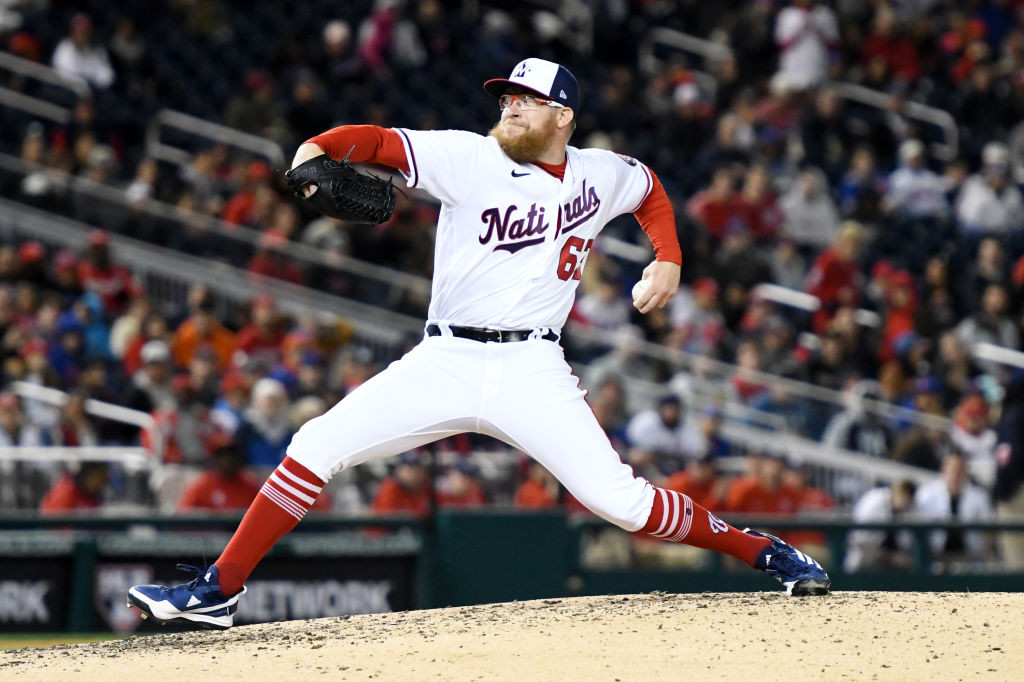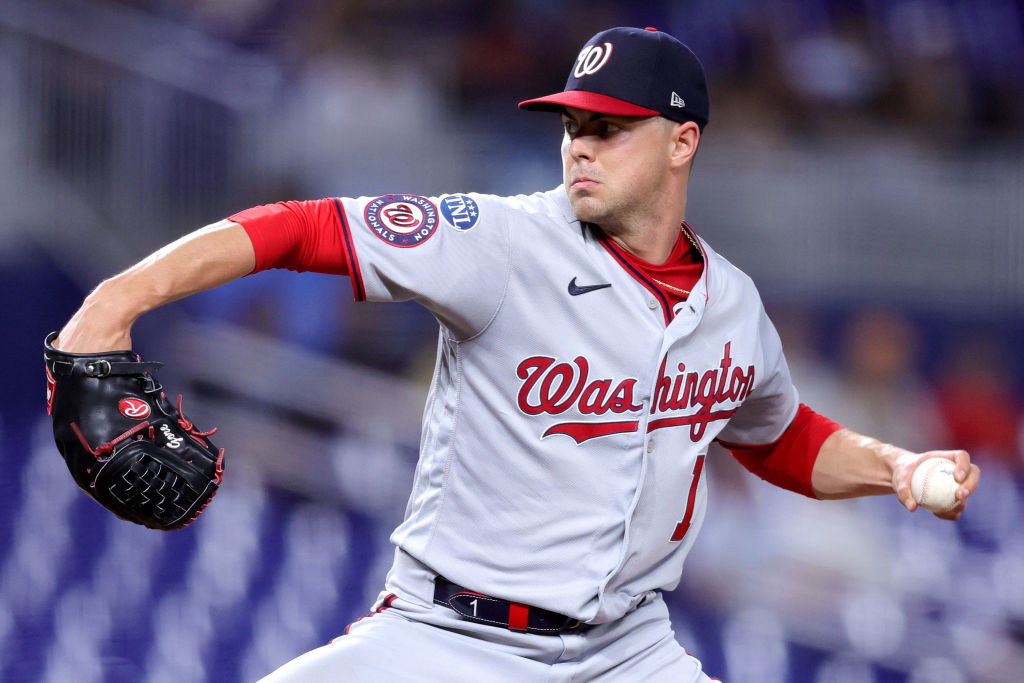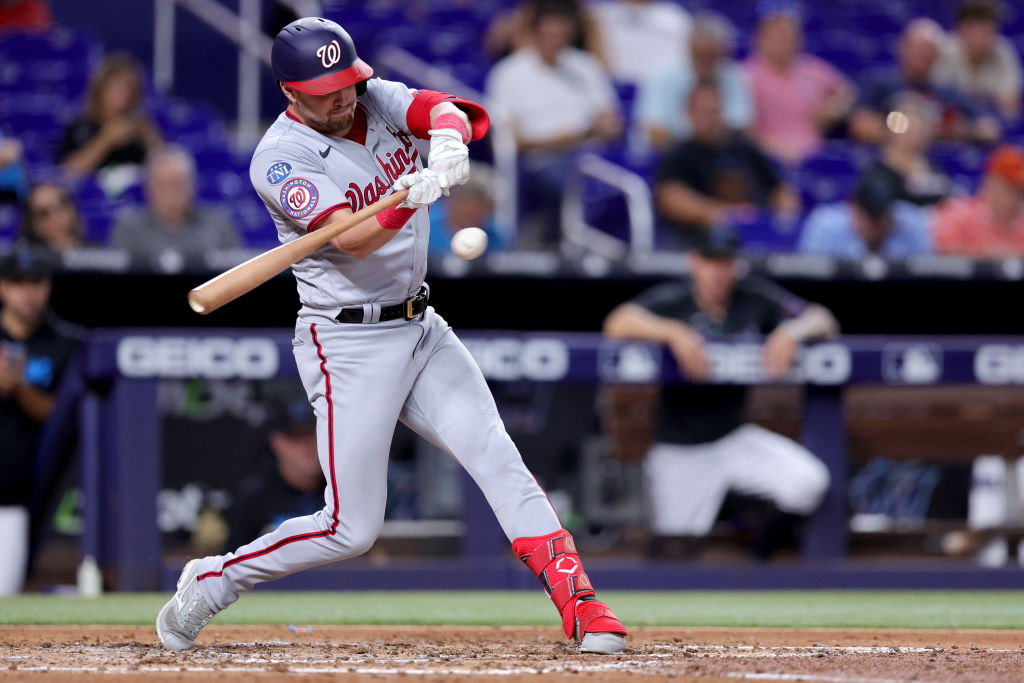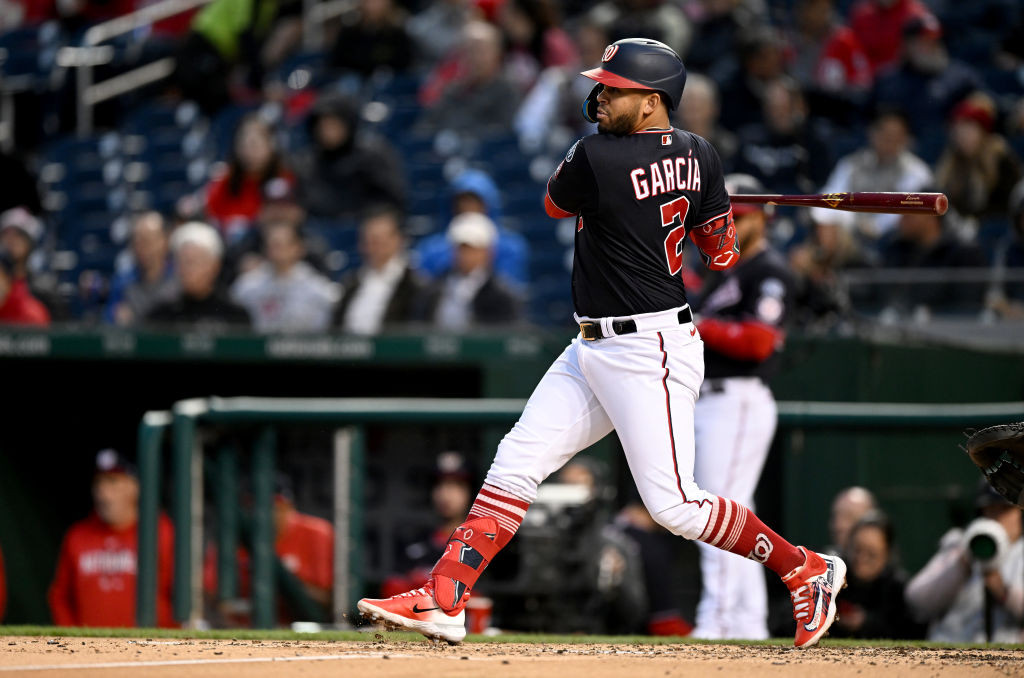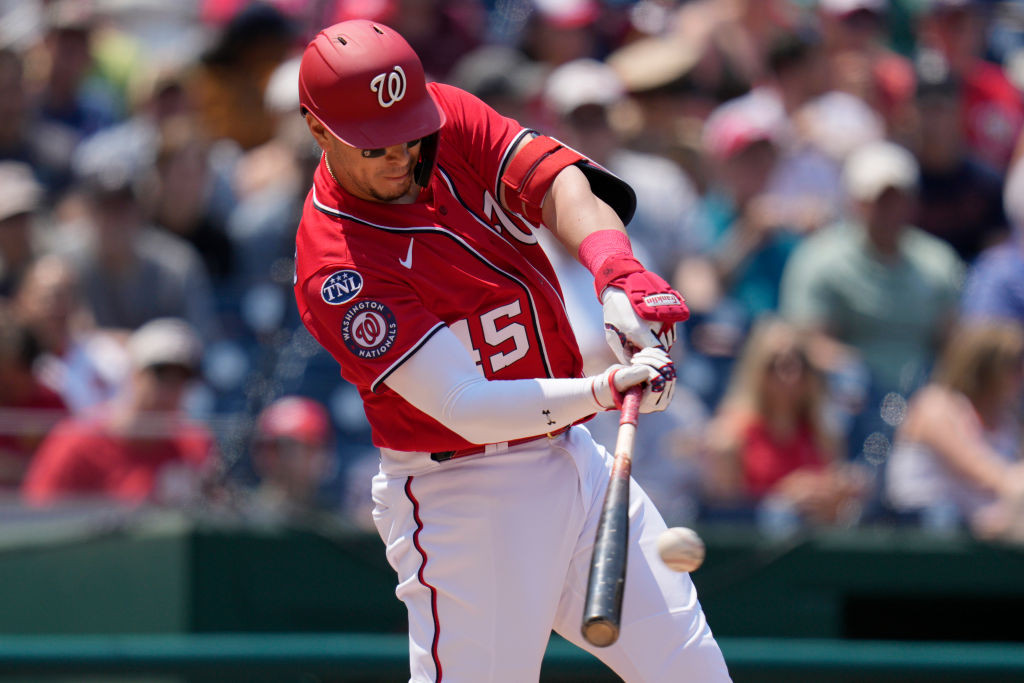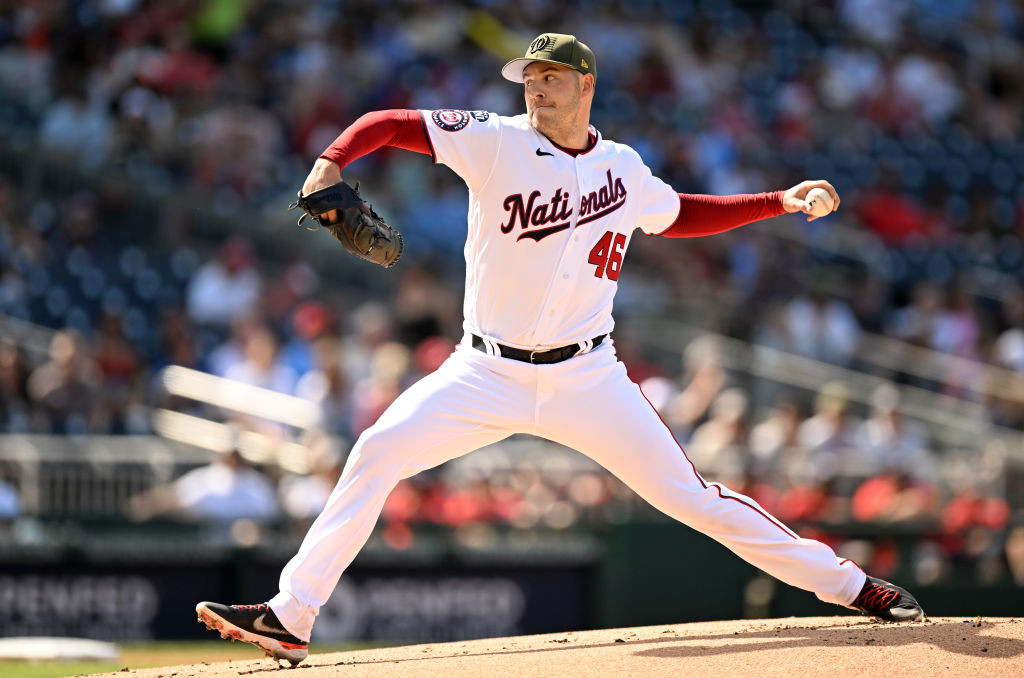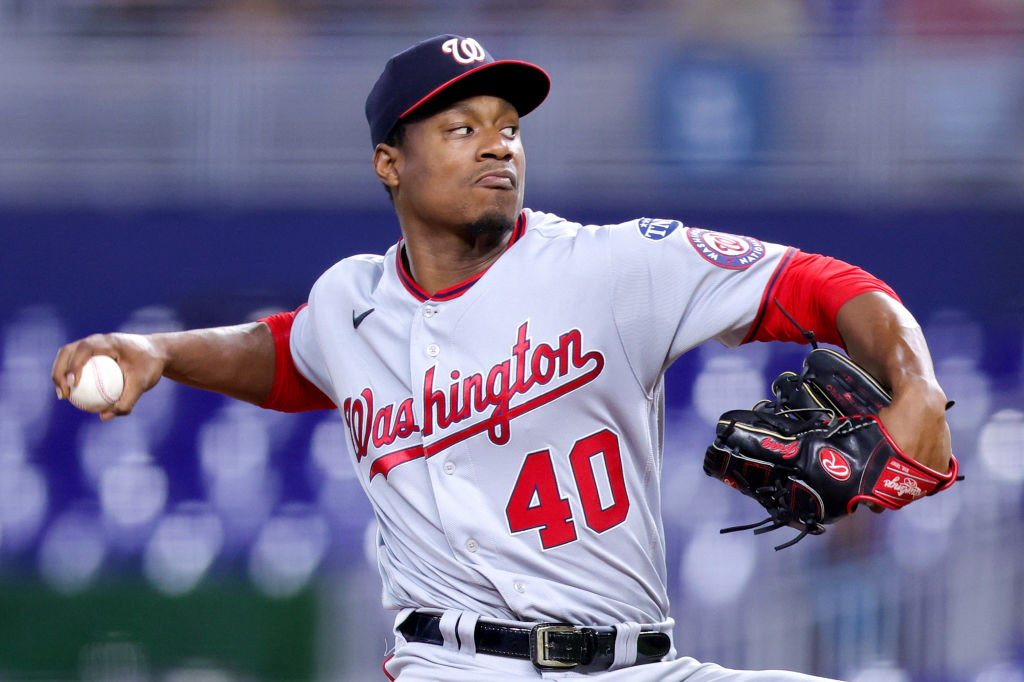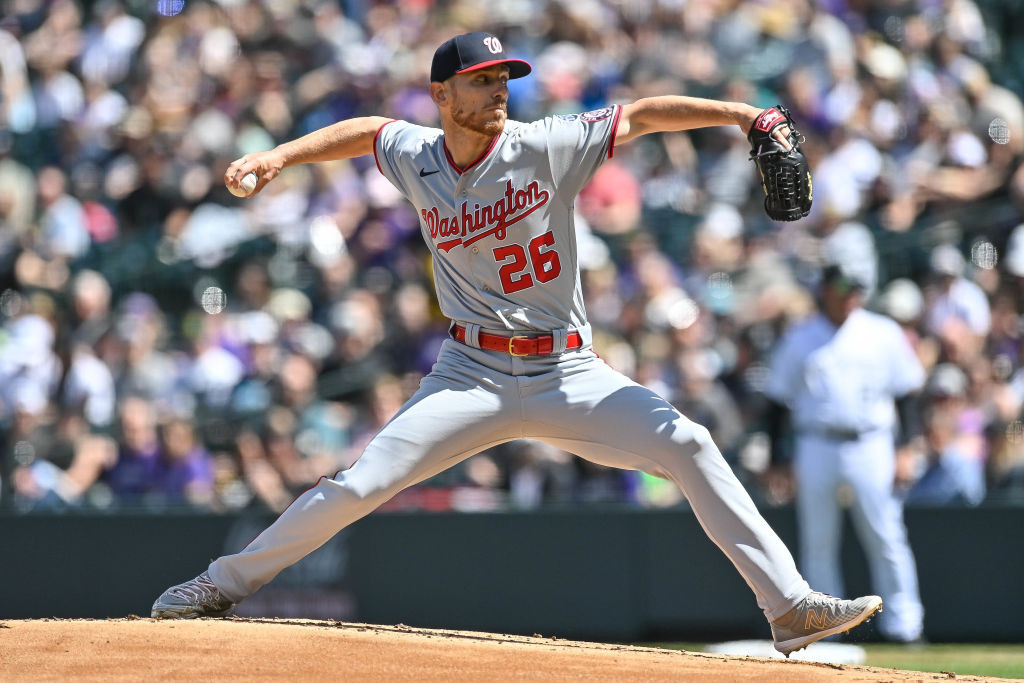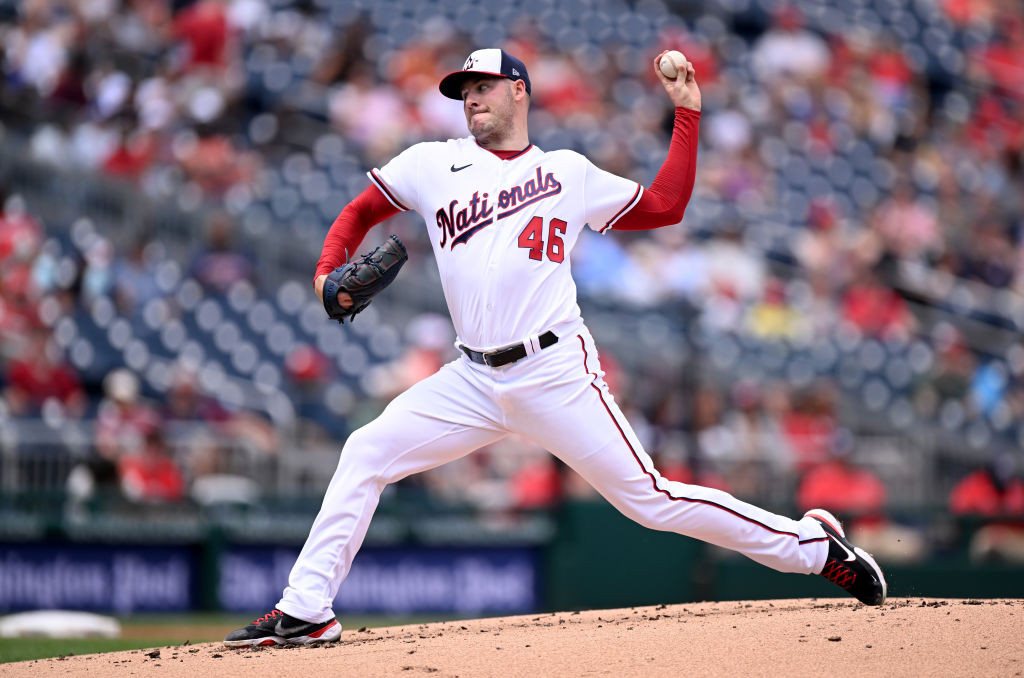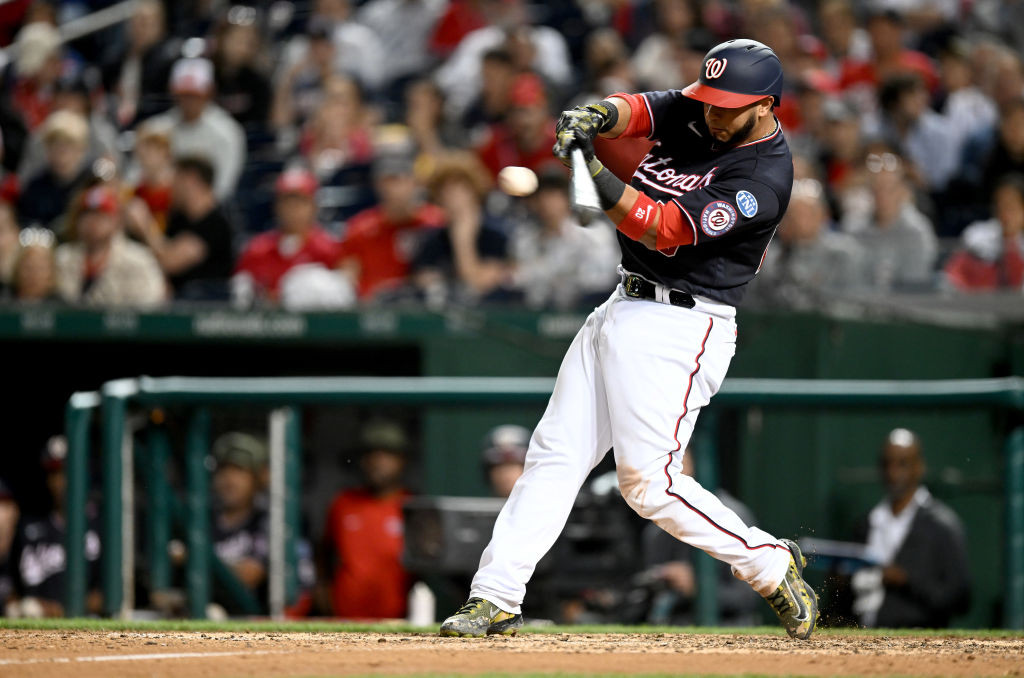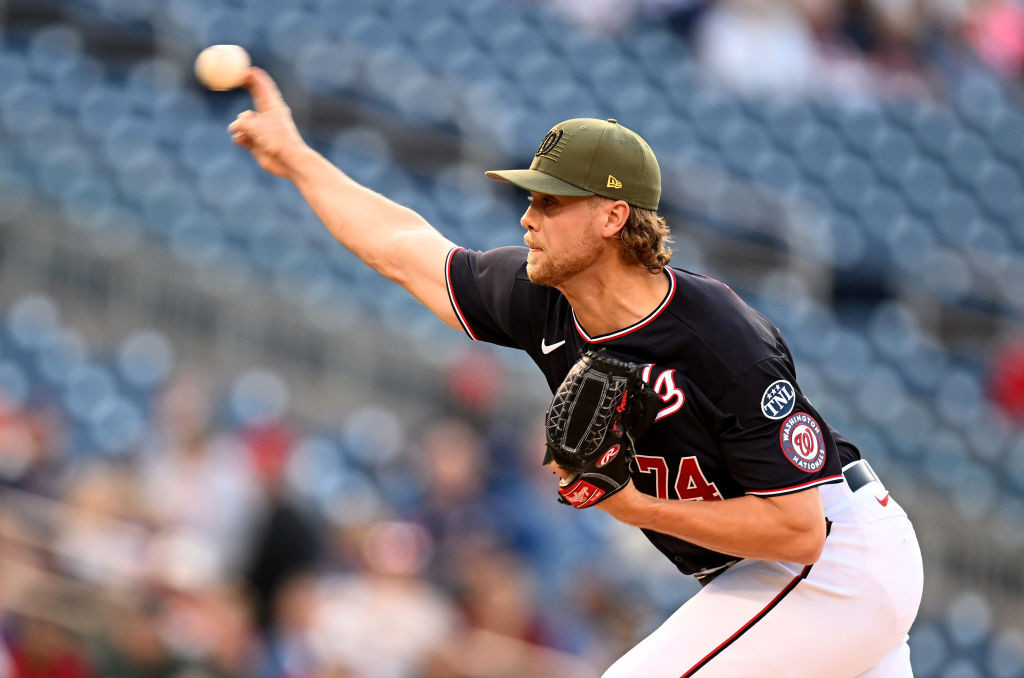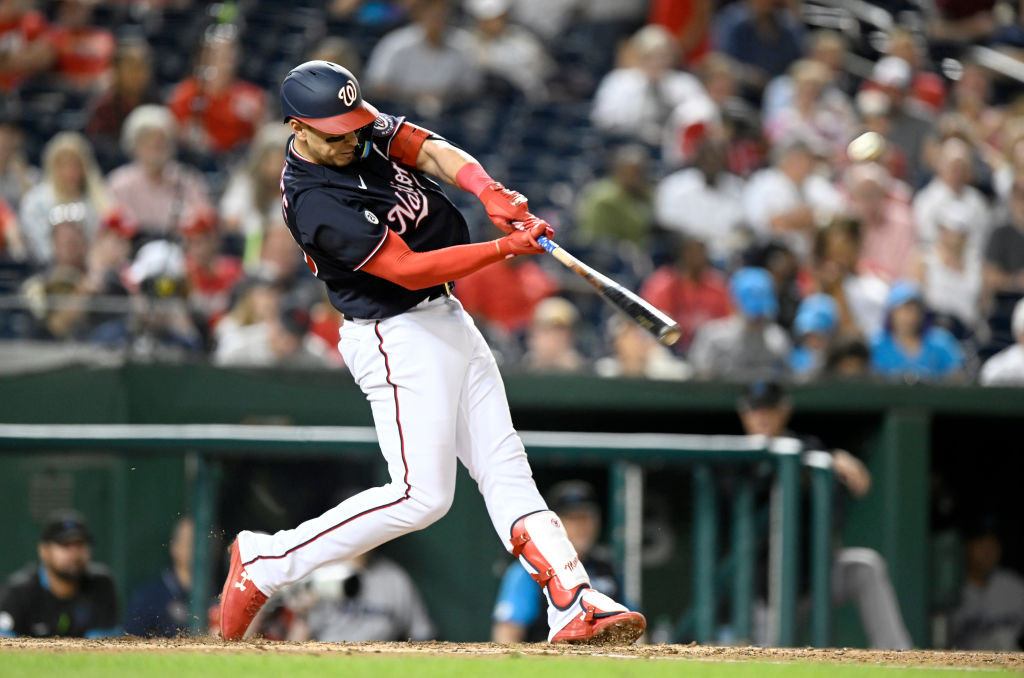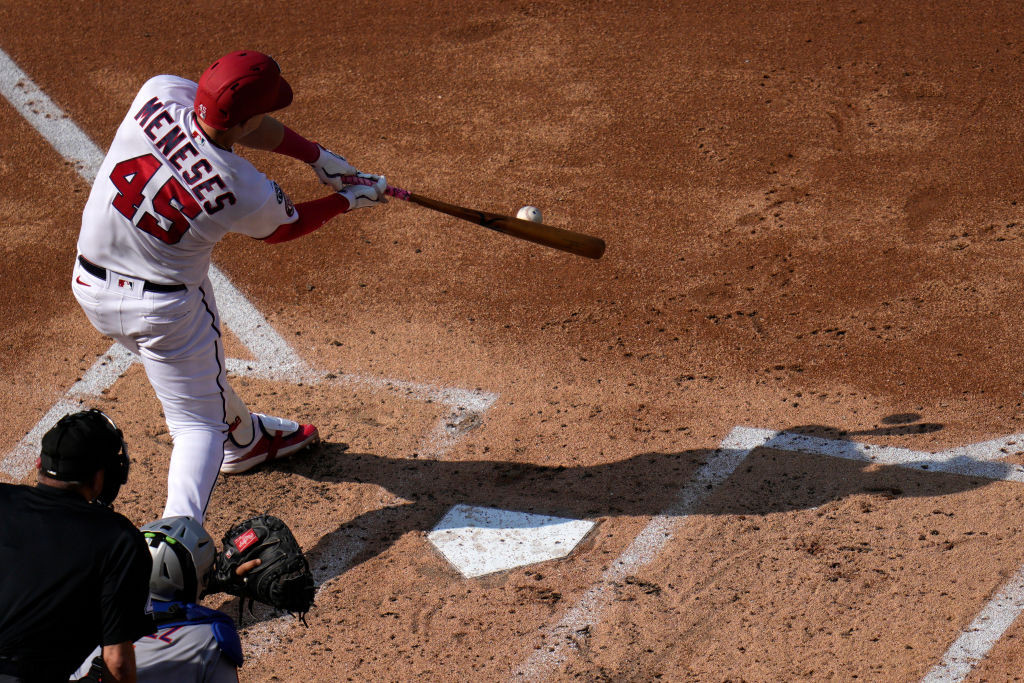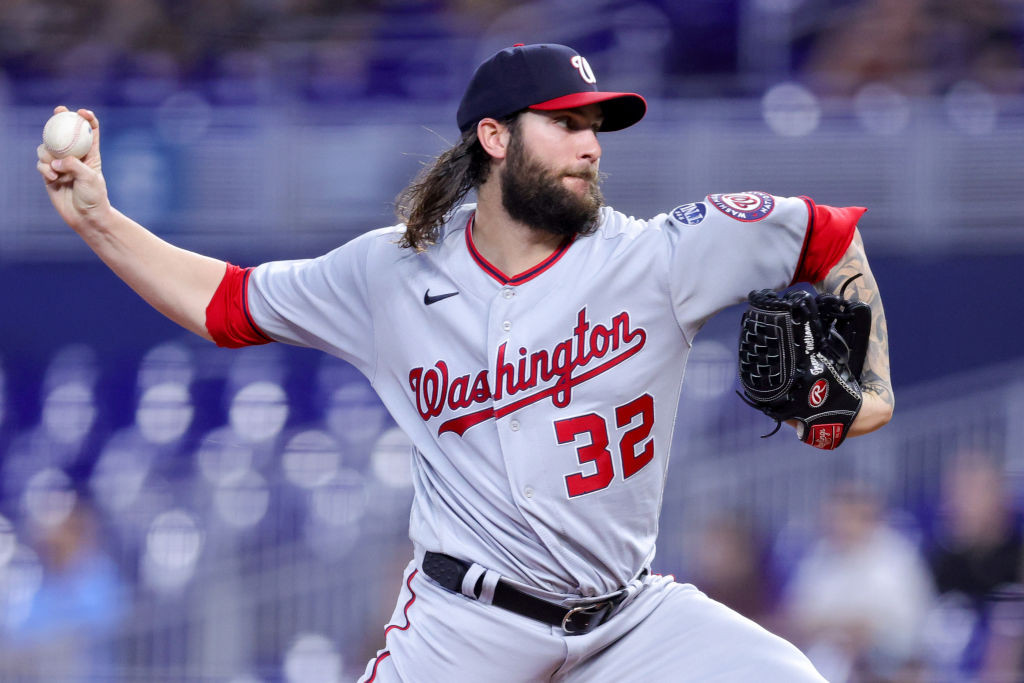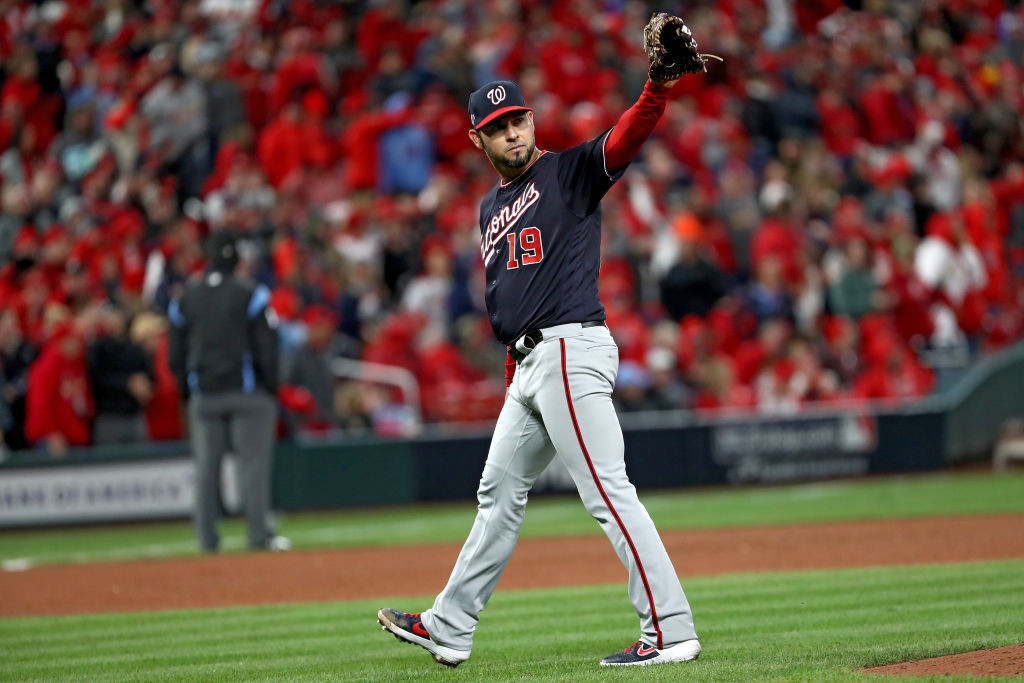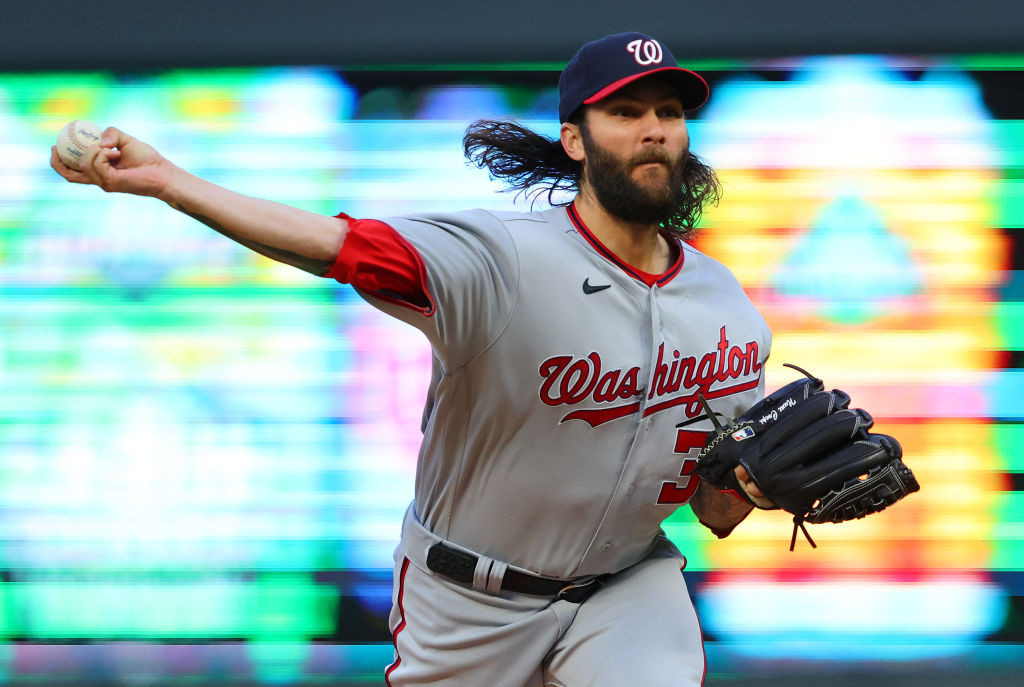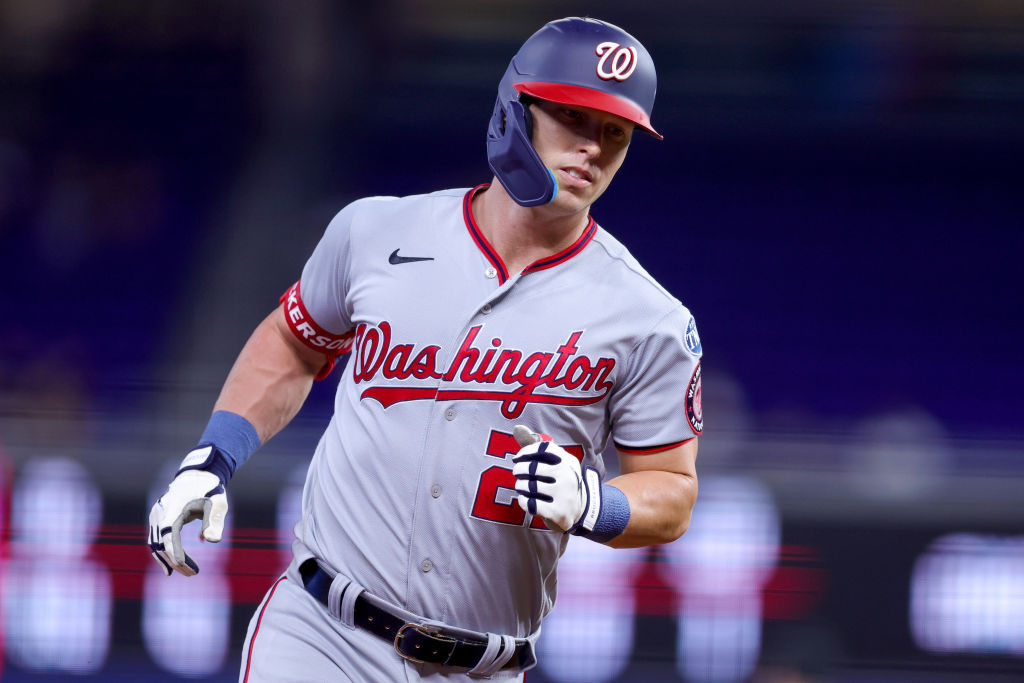Sean Doolittle is making a significant step in his recovery from an elbow procedure done last year.
Rehabbing at the Nationals' facility in West Palm Beach, Doolittle will start throwing on back-to-back days, the next benchmark he’s been working toward for a while.
“Sean Doolittle is gonna go back-to-back days now,” manager Davey Martinez said during his pregame media session. “Once he does that, then we'll reassess and go from there.”
The veteran left-hander was limited to just 5 ⅓ innings in six games with the Nationals last year before being shut down with an elbow injury. After trying to just rest it, Doolittle decided to undergo a similar but less invasive procedure as Tommy John surgery with the hope that he would recover faster and be able to pitch this season.
He reported to spring training healthy on a minor league deal, but was ultimately shut down out of precaution of ramping up too fast. If Doolittle feels good after throwing back-to-back games, the Nationals could start looking to get him into game action.
Hey, have you heard Juan Soto is back in town? OK, so it is of course a big deal that the 24-year-old slugger is back in D.C. for the first time since mid-August, the second time since he was traded to the Padres. We’ll see what kind of reaction he gets from the crowd when he comes up to bat in the top of the first tonight … against one of the guys he was traded for.
Yes, adding some spice to tonight’s series opener is the presence of MacKenzie Gore on the mound for the Nationals. This will of course be Gore’s first career start against San Diego, and he’ll be challenged to keep his emotions in check and not get too amped up about the matchup.
Yu Darvish starts for the Padres, and that’s always a challenge for any lineup, let alone one with as little experience as the Nats have. Given how many different types of pitches Darvish throws, guys will have to be patient and focus on swinging at good pitches, not just anything that looks like a strike (especially early in the count).
WASHINGTON NATIONALS vs. SAN DIEGO PADRES
Where: Nationals Park
Gametime: 7:05 p.m. EDT
TV: MASN2, MLB.tv
Radio: 106.7 FM, MLB.com
Weather: Hazy, 72 degrees, wind 11 mph in from right field
NATIONALS
RF Lane Thomas
2B Luis García
3B Jeimer Candelario
DH Joey Meneses
LF Corey Dickerson
C Keibert Ruiz
1B Dominic Smith
CF Alex Call
SS CJ Abrams
When Juan Soto takes the field at Nationals Park tonight in a Padres uniform, it will still sting for any number of people who still have a hard time fathoming the 24-year-old slugger wearing anything other than a curly W on his head.
It might, however, sting a little less if MacKenzie Gore and CJ Abrams do their part to lift the home team to victory, reminding all those suffering souls why Soto was traded in the first place and why the Nationals could emerge from the wreckage in a better place when it’s all said and done.
This isn’t Soto’s first trip back to D.C. That already happened last August, only 10 days after he was dealt to San Diego along with Josh Bell for six players, five of them promising young prospects. The emotions were still raw at that time, and the image of perhaps the greatest player in Nats history coming up to bat against them was tough for everyone to take.
The passage of time eases some of the pain. But perhaps even more than that, the emergence of the first two of the prospects acquired in the trade at the big league level helps make it far more tolerable. No, neither Gore nor Abrams has come close yet to matching Soto’s status. But each has offered up enough this season to make you believe stardom is on the horizon.
Gore, in particular, has stood out. Unable to make his Nationals debut last season because he was still recovering from an elbow injury in August and September, he’s now nine starts into his Nats career. And the results, while erratic, have been overwhelmingly positive in the big picture.
Lane Thomas knows his reputation. He’s been a streaky hitter ever since arriving in Washington at the 2021 trade deadline.
It really became noticeable last season, one that saw Thomas finish with a .705 OPS but only after experiencing the following month-by-month roller coaster: .496, .661, .864, .587, .775, .724. So the Nationals right fielder vowed to try to be more consistent this year, recognizing the importance of avoiding the long streaks (good or bad) that had come to define him.
And how has he done with that? Well, the .629 OPS he posted in April followed by the .944 mark he has delivered so far in May suggests he’s on his way to another roller-coaster season.
Unless Thomas can capture what he’s done this month and sustain something like it throughout the summer and into the fall. Which, of course, is easier said than done.
“I feel like I’m trying to be a little more consistent this year,” he said. “That’s something I wanted to focus on: What got me into a streak? I felt like I was a little streaky. I’d get a few hits one series last year, and then no hits. I’m just trying to be more consistent in approach and with at-bats late in games. Hopefully that’s paying off a little bit and I can keep doing it.”
Luis García’s day off Saturday was somewhat significant, though hardly big news. But when García’s name again wasn’t in the Nationals’ lineup for today’s series finale against the Tigers, it raised eyebrows.
Is the Nats second baseman hurt? Is he being benched for lack of performance?
“No,” manager Davey Martinez said this morning. “I had a conversation with him. This is just kind of a reset for him.”
García certainly merited a break after starting 21 consecutive games and appearing in 33 straight games since missing four days with a tight hamstring early last month.
More than that, Martinez noticed the 23-year-old showing signs of pressing in recent days. García was 1-for-11 with five strikeouts over his last three games. He also committed his first error of the season during Friday night’s loss, a costly mistake that prolonged the top of the third inning for starter Jake Irvin, who wound up not even completing the inning.
Much as major league managers wish it wasn’t so, the path to victory on any given day isn’t always going to be a straight one. The Nationals made life easy on Davey Martinez during Saturday’s low-drama win over the Tigers, getting a quality start from Patrick Corbin and clutch hits from the lineup to take the lead, allowing the skipper to use his traditional bullpen alignment late to close it out.
This afternoon did not afford Martinez such luxuries. Though the Nationals stormed out of the gates to take a five-run lead and ultimately rapped out 18 hits, they still needed several escape acts from their top relievers – some of them in unfamiliar roles – to emerge with a 6-4 win over Detroit.
In order to capture this weekend series, the Nats not only needed home runs from backups Riley Adams and Ildemaro Vargas, plus another four-hit game from Jeimer Candelario against his former team. They needed Josiah Gray to gut his way through five innings of one-run ball despite six walks. And then they needed Kyle Finnegan (owner of nine saves) to pitch out of a jam in the sixth and return for the seventh, ultimately setting up Carl Edwards Jr. and Hunter Harvey to close out perhaps the weirdest win of the season.
"It was definitely weird," Martinez said. "We did some things just to get out of some jams."
Edward, Harvey and Finnegan each pitched Saturday, in that order, with Finnegan earning his ninth save of the season in a 5-2 victory. Not 24 hours later, Martinez was summoning Finnegan out of the bullpen to clean up a sixth-inning jam created by Andres Machado, then asking him to return for the seventh as well.
The Nationals’ rally last night came up just short. Down 8-0 in the series opener to the Tigers, they were able to come back to make it a two-run game late, but eventually fell 8-6.
They faced another deficit Saturday. Though this one was not nearly as large, they were able to complete the comeback for a 5-2 win in front of 31,721 fans on a beautiful day at Nats Park.
Patrick Corbin got them in a hole early by giving up a first-pitch single to Matt Vierling to start the game and then a two-run home run to slugger Spencer Torkelson three batters later. It wasn’t necessarily a bad pitch – a 92 mph four-seam fastball in the upper right corner of the strike zone – but Torkelson was just able to muscle it out.
“It was a fastball up," the left-hander said of the home run ball after the game. "Tried to get it in, kind of leaked out over. But still felt really good. Located fastball well today. They're a pretty aggressive team, so a lot of quick outs and some early hits that I gave up as well. But defense was great behind me. Overall, felt pretty good.”
As Corbin has done more often this season than in the past three, he didn’t let the early homer derail his start. He was steady from that point on to turn in his fourth straight quality start and his sixth in his last seven outings.
The Nationals ended a four-game losing streak Saturday with a solid, 5-2 victory over the Tigers. They’d love to make it two in a row today and take the weekend series in the process.
The Nats have Josiah Gray on the mound, and that usually means they’re going to have an excellent chance of winning. The right-hander really has become their most reliable starter, having allowed three or fewer runs in each of his eight starts since his rough season opener and two or fewer runs in all but one of those starts. He’s also completed seven innings each of the last two times he’s pitched, further evidence of his growth since last year.
The Nationals have faced a bunch of lefties recently, and they get another one today in Detroit’s Joey Wentz. The 25-year-old impressed as a rookie last season, posting a 3.03 ERA and 1.102 WHIP in the first seven starts of his career. He’s been far less successful so far this season, with a 6.38 ERA and 1.445 WHIP through eight starts. Strangely enough, Wentz’s strikeout and walk rates have remained almost the same. The biggest difference from last year: He’s giving up a lot more hits, especially home runs (seven in only 36 2/3 innings).
Davey Martinez is going with a different look in his lineup this afternoon. Stone Garrett will bat cleanup against the lefty, and Riley Adams is giving Keibert Ruiz a well-deserved day off. But the most notable difference is that both CJ Abrams and Luis García are on the bench (García for the second straight day). So it’s Ildemaro Vargas and Michael Chavis up the middle of the infield.
WASHINGTON NATIONALS vs. DETROIT TIGERS
Where: Nationals Park
Gametime: 1:35 p.m. EDT
TV: MASN2, MLB.tv
Radio: 106.7 FM, MLB.com
Weather: Sunny, 74 degrees, wind 11 mph in from left field
It’s common during homestands to find Nationals players out and about in D.C., getting active in the community. The organization has been committed to giving back to the area for a long time, centered around its Youth Baseball Academy.
But the players don’t have to be at the academy to get involved in youth baseball around town. That’s why Dominic Smith and other Nats players found themselves in Livingston Park in Chevy Chase yesterday morning with a group of Capitol City Little League kids – my 8-year-old nephew Jack included – ahead of their late-afternoon game.
“I had a great time today,” Smith said Saturday before the Nats’ 5-2 win over the Tigers. “Over there, Capitol City Little League, got to see a bunch of different age groups from like 8 to like 12. And just to see them, see the energy that they brought, I kind of fed off of that and I had a great time. Those kids are very competitive. They got some really good coaches out there because some of those swings were really impressive, especially for the age groups. And it was just fun. It was a great day to just spend some time with them and get to show them who I am as a person because sometimes they don't get to see stuff like that.”
Smith and the kids went through typical baseball drills like hitting balls off a practice tee. It must feel good as a kid to get a couple of good hacks in and have a major leaguer be impressed by your swing.
And the kids should be impressed by Smith’s swing as of late. Before yesterday’s 0-for-4 outing, he had been hitting .343 over his previous 20 games to raise his batting average by 54 points.
The Nationals have made their decision on Chad Kuhl. He was officially reinstated from the 15-day injured list, while Hobie Harris was optioned to Triple-A Rochester.
Kuhl had been on the IL with a right foot issue since April 30 and threw 65 pitches over four simulated innings Monday. He played catch yesterday before the Nats made their final decision on the roster move.
The other intriguing part of his return is that the Nationals plan to utilize him out of the bullpen. That is so they can both monitor his innings while he provides length in the ‘pen and keep Jake Irvin in the rotation.
“It gives us length in the bullpen, which will be nice,” manager Davey Martinez said during his pregame media session. “But he's just coming back, so I want to make sure, as we do this, that he probably gets clean innings. But he definitely gives us multiple innings if we need. The last sim game, he threw the ball exceptionally well. He was up in the mid-90s with his fastball, was throwing strikes. Slider was really, really good. So that was encouraging. So we'll get him in the bullpen and get him going. And then we'll see where it takes us.”
Other options included having him go on a minor league rehab assignment to build up his pitch count more. The Nats also could have kept him here to pitch another sim game. Or they could have activated him back into the rotation and optioned Irvin back to Rochester.
Happy Star Wars Day from Nationals Park! The team is giving away dueling light side vs. dark side Hawaiian shirts to fans today, so make sure you get to the gates on time.
On the field, the pitching duel sees Patrick Corbin making his 10th start of the season for the light side and Alex Faedo starting for the dark side.
Corbin is 2-5 with a 4.65 ERA and 1.430 WHIP entering this afternoon’s game. He has pitched much better over his last six starts, to the tune of a 3.47 ERA, though he is only 1-3 in those outings and the Nats have split them evenly.
Faedo is the only right-hander scheduled to start for the Tigers this weekend. The 27-year-old former first-round pick is making his third start of the season. He is 0-1 with a 4.22 ERA over his first two, with the Tigers having lost both games. He is 1-5 with a 5.32 ERA and 1.492 WHIP over the first 14 starts of his young career.
There’s a chance of rain tonight, supposedly starting around 6 p.m. Here's hoping we can avoid a repeat of last Saturday’s suspended game and either finish this one in time or avoid getting wet all together.
When the bottom of the sixth arrived at Nationals Park on Friday night, a zero still showing in the home team’s hit column, Lane Thomas decided to just go ahead and say what surely others in the ballpark were thinking at the time.
“I just started screaming: ‘He’s throwing a no-hitter!’ the outfielder said. “I think nobody really knew. I was like: ‘Hey guys, we’ve got to get one here soon!’”
Indeed, the Nationals had not been able to make any dent into Tigers starter Matthew Boyd, who through five scoreless innings had walked one batter and plunked another but had not surrendered anything close to a clean base hit and had faced the minimum thanks to a couple of double plays.
This was rare territory for the Nats, who remarkably still have not been no-hit in club history. The streak actually dates all the way back to July 18, 1999, when David Cone tossed a perfect game against the Expos at Yankee Stadium. The only franchise to enjoy a longer streak without being no-hit: the Athletics, who haven’t had it happen to them since four Orioles pitchers stymied them on July 13, 1991.
The Nationals have had a few close calls over the years, none closer than Sept. 24, 2013, when Cardinals rookie Michael Wacha was one out away from a no-hitter at Busch Stadium when Ryan Zimmerman narrowly beat out an infield single to save his team from suffering that ignominy.
When Chad Kuhl landed on the 15-day injured list at the beginning of the month, the Nationals decided to promote Jake Irvin from Triple-A Rochester and see what they had in this 26-year-old right-hander.
After a solid, though flawed major league debut against the Cubs, there was enough reason to want to see more of Irvin. After an eye-opening, 6 1/3 innings of scoreless ball in San Francisco, there was reason to wonder if Irvin might really be legit. And though his third start ended with a nightmare fifth inning, Irvin performed well enough against the Mets up to that point to warrant another look.
So, now what?
Irvin’s fourth career start didn’t come close to producing the promising moments of his previous three. Rocked by the weak-hitting Tigers for six runs in only 2 2/3 innings, he dug the Nationals into a deep hole they nearly climbed all the way out of before falling 8-6 in the opener of a weekend interleague series.
"Tomorrow, we've got to come out ready to play," an unusually perturbed Davey Martinez said. "From the first pitch on."
Joey Meneses was hesitant to leave Washington with the rest of his Nationals teammates following Monday’s win over the Mets, given what was going on in his personal life. Though Meneses’ wife, Mitzy Guzman, wasn’t due to give birth to the couple’s first child until later in the month, she went to the hospital that day with some discomfort, only to be sent back home when doctors told her nothing appeared imminent.
So Meneses went to Miami and played in Tuesday night’s loss to the Marlins, going 0-for-3 with a walk. Then his phone rang at 4 a.m., and he heard the news: Guzman’s water had broken, and she was going back to the hospital in labor.
Meneses scrambled to get on the first available flight back home Wednesday morning. He did not, however, make it in time to witness the birth of Joseph Meneses Guzman.
“Unfortunately, the baby was born around 12:30, and I didn’t get there 'til about 2 o’clock,” Meneses shared today, via interpreter Octavio Martinez. “By the time I landed and got through the airport and everything, I got here a little later than I wanted.”
“That’s OK,” Meneses added in English with a wide smile. “He’s healthy and good.”
It was a frustrating three days for the Nationals in Miami, where they lost three straight to the Marlins by a grand total of four runs. They continue to play close games, but they’re still learning how to consistently win a majority of those games.
They’ll give it another try this weekend with an interleague series against the Tigers, a team that’s also rebuilding and is also performing a little better than expected so far this season. Detroit is 19-22 despite a run differential of minus-48. (For comparison’s sake, the Nats are 18-26 with a run differential of minus-24.)
Like the Nationals, the Tigers don’t hit a lot. They’re last in the American League in runs, hits and on-base percentage, second-to-last in homers, walks, slugging percentage and OPS. Catcher Jake Rogers leads the team with five homers. Shortstop Javier Báez leads the team with 19 RBIs. Veteran left-hander Matthew Boyd, in his second stint with Detroit, is on the mound tonight. He was roughed up by the Mariners in his last start, allowing five runs and failing to get through the second inning.
Jake Irvin makes his fourth career start for the Nats, hoping to do what he’s done through the majority of his first three and just avoid the one bad inning that plagued him last week against the Mets.
Joey Meneses is back from his paternity leave and the Nationals have optioned Jake Alu back to Rochester to make roster room.
MIAMI – The Nationals can’t seem to catch the Marlins for whatever reason. They came into this afternoon needing a victory to avoid a three-game sweep.
Although Trevor Williams pitched a quality start and Jeimer Candelario continued with his hot bat, the Nationals fell again to the Fish by a score of 5-3 in front of an announced crowd of 7,752 at loanDepot Park.
“Tough game," manager Davey Martinez said after the loss. "We tried to make a comeback there, just couldn't finish it. We just didn't hit enough this series. I thought we pitched pretty good. Just the bats got cold on us. So we gotta come back and start swinging the bats, get the ball in the strike zone. We had one ending there where I thought things were gonna snap out of it and then we hit into a double play. So tough series, like you said, and we just gonna come back tomorrow and be ready to play.”
This has become all too familiar for the Nats. They have now lost six of their last seven series against Miami dating back to last year, and have been swept four times.
The Nationals had trouble with Marlins rookie right-hander Eury Pérez, who was making just his second major league start. The 20-year-old is the Marlins’ top-ranked prospect, the No. 7 ranked prospect in all of baseball and the No. 2 ranked right-handed pitching prospect in the sport, per MLB Pipeline. He came in with a fastball that sits at 94-97 mph and peaks at 100, a deceptive upper-80s changeup, an upper-70s curveball and a mid-80s slider.
MIAMI – Aníbal Sánchez’s career was one that was well traveled. Sixteen major league seasons brought him many personal accomplishments, which all led to the ultimate prize in his last true full campaign.
So when the 39-year-old finally made the decision to retire and he sat down to write out his announcement before posting it on his Instagram account, he had a lot to look back on and be proud of.
“I think just yesterday when I post my (announcement) and I noticed everybody that I'm retiring, I saw 17 years pass in two minutes and a half. It was incredible,” Sánchez said Wednesday afternoon in the Nationals dugout at loanDepot Park with media members from both Washington and Miami surrounding him and his family looking on. “Sounds easy, but it's not like that. The most thing that I'm proud of me through my whole career, I past bad moments and I had always the power to come back and keep going in my career.”
Sánchez retired after 16 major league seasons. He spent parts of seven with the Marlins, parts of six with the Tigers, one with the Braves and the last three with the Nationals. He is the owner of a no-hitter, one of the most impressive postseason performances in history and a World Series championship ring.
“I think for me, every single day I come to the field and most of the things that I say to the guys is just working hard,” he said. “It's a sport for everybody else, but it's work and a job for us. So take it serious, work hard and we're going to have time for everything. For having fun, for working out, for preparing our game, for being outside and making it a good show for the fans and also make some wins for the team.”
MIAMI – Cade Cavalli’s face lit up as he entered the Nationals clubhouse at loanDepot park this morning. It was the first time he was going to be around his teammates since they broke camp in West Palm Beach back in March.
If only for a few days, the young right-hander is leaving the monotony of rehabbing his right elbow at the Nats' spring training facility after Tommy John surgery and join the team for a weekend back in D.C.
Cavalli arrived with a suitcase and equipment bag in tow. He quickly changed out of his street clothes and into his Nationals gear. Though he won’t pitch this year, he was a part of the team again.
“I'm gonna fly with the team tonight to D.C. and spend the weekend there with them,” Cavalli said with the joy clearly across his face. “It'd be great to be able to get back to D.C. and hang around the guys for more than one day. So I'm really excited about it. It's gonna be a great change of scenery for me. And then right back to Florida, and we're getting right back after it.”
It’s only two months into a lengthy rehab process, but Cavalli has made significant strides that have him and the organization optimistic about his recovery and return next year.
MIAMI – After dropping the first two games here against the Marlins, the Nationals need a win this afternoon to avoid a sweep.
That’s a position they are all too familiar with from last year. The Nationals lost five of their six series against the Fish in 2022, putting themselves in position to get swept in all five, and actually losing each game of the series three times.
They’ll rely on former Marlins draft pick Trevor Williams to help get the job done. Williams, who was a second-round pick by the Marlins in 2013, brings a 1-1 record, 4.23 ERA and 1.304 WHIP to his ninth start of the season. Having pitched in the National League his entire career to date, and with the Mets the previous two seasons, he has substantial history against Miami, going 1-1 with a 3.60 ERA in nine appearances (four starts).
Eury Pérez gets the call for his second major league start for the home team. He is young, but has a big presence on the mound as the 20-year-old right-hander is listed at 6-foot-8 and 220 pounds. Signed as an international free agent out of the Dominican Republic in 2019, he is the Marlins’ top-ranked prospect, the No. 7 ranked prospect in all of baseball and the No. 2 ranked right-handed pitching prospect in the sport, per MLB Pipeline. He had a 2.32 ERA over six starts with Double-A Pensacola before getting the call to the majors, skipping Triple-A ball.
Pérez gave up two runs on four hits and two walks with seven strikeouts over 4 ⅔ innings in his major league debut Friday against the Reds. He has a fastball that sits at 94-97 mph and peaks at 100, a deceptive upper-80s changeup, an upper-70s curveball and a mid-80s slider.
MIAMI – It had been 46 days since Corey Dickerson’s last at-bat in a major league game. He was 0-for-3 with a walk over the Nationals’ first two games of the season before landing on the 10-day injured list with a left calf strain.
So, forgive him for not wasting any time in giving the Nats a big swing when he stepped to the plate for the first time last night, his first game since being activated off the IL on Monday.
Dickerson jumped on the second pitch he saw from Marlins starter Edward Cabrera, a 97 mph sinker right down the middle of the plate and crushed it 432 feet into the right-field upper deck of loanDepot Park. The ball left his bat at 109 mph, the fastest exit velocity by any hitter last night to go along with the furthest distance of any hit ball.
“That was one of those that I finally got my timing the way I wanted working on it down there (on his rehab assignment),” he said after the 4-3 loss. “And yeah, it's one of those you don't forget. But it's also good to have just a hard hit ball just so you can remember. That's good going forward. You can keep that in the back of your mind and know that you did it and you're not having to search for it. You know it's in there. So just get your work in and compete.”
All of his frustrations from the past month and a half let out on his first swing. That poor baseball.


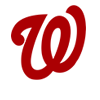

-1745819772711.png)
